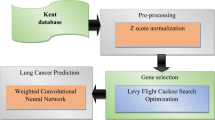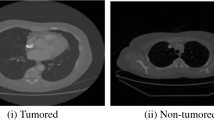Abstract
The main intent of this paper is to design and implement a novel methodology for lung cancer prediction using the patient's health record. Feature extraction is performed using two well-performing approaches like principal component analysis (PCA) and t-distributed stochastic neighbor embedding (t-SNE). As an innovative contribution, a novel optimized correlation-based weighted feature extraction method named as self adaptive sea lion optimization algorithm (SA-SLnO) has been proposed that uses the latest meta-heuristic algorithm to optimize the weights. The number of hidden neurons in RNN is optimized by the proposed SA-SLnO. The major objective of this proposed lung cancer diagnosis model is to minimize the MSE among the actual and predicted outputs. The experimental findings demonstrate that the proposed model outperforms existing methodologies in terms of accuracy, sensitivity, and precision, FPR, FNR, and F1-score. Experimental finding demonstrates that proposed work outperforms PSO-RNN, GWO-RNN, GSO-RNN, and SLnO-RNN in terms of accuracy by 1.7 percent, 2%, 5%, and 2.7%, respectively. Similarly, the proposed lung cancer diagnosis model performed better when all performance metrics are examined on two datasets.










Similar content being viewed by others
References
Alahmari SS, Cherezov D, Goldgof DB, Hall LO, Gillies RJ, Schabath MB (2018) Delta radiomics improves pulmonary nodule malignancy prediction in lung cancer screening. IEEE Access 6:77796–77806
Arunkumar C, Ramakrishnan S (2019) Prediction of cancer using customized fuzzy rough machine learning approaches. Healthc Technol Lett 6(1):13–18
Colquhoun AJ, McHugh L, Tulchinsky E, Kriajevska M, Mellon J (2007) Combination treatment with ionising radiation and gefitinib (‘Iressa’, ZD1839), an epidermal growth factor receptor (EGFR) inhibitor, significantly inhibits bladder cancer cell growth in vitro and in vivo. J Radiat Res 48(5):351–360
Dataset 1: https://www.kaggle.com/datasets/h13380436001/h-lung-cancer.
Dataset 2: https://www.kaggle.com/datasets/aemreusta/brfss-2020-survey-data
Engchuan W, Chan JH (2015) Pathway activity transformation for multi-class classification of lung cancer datasets. Neurocomputing 165:81–89
Jakimovski G, Davcev D (2019) Using double convolution neural network for lung cancer stage detection. Appl Sci 9(3):427
Kang X, Xiang X, Li S, Benediktsson JA (2017) PCA-based edge-preserving features for hyperspectral image classification. IEEE Trans Geosci Remote Sens 55(12):7140–7151
Kaucha DP, Prasad PWC, Alsadoon A, Elchouemi A, Sreedharan S (2017) Early detection of lung cancer using SVM classifier in biomedical image processing. In: 2017 IEEE International Conference on Power, Control, Signals and Instrumentation Engineering (ICPCSI), pp 3143–3148
Kim T-W, Koh D-H, Park C-Y (2010) Decision tree of occupational lung cancer using classification and regression analysis. Saf Health Work 1(2):140–148
Krawczyk P, Kucharczyk T, Wojas-Krawczyk K (2012) Screening of gene mutations in lung cancer for qualification to molecularly targeted therapies. INTECH Open Access Publisher
Krishnaiah V, Narsimha G, Subhash C (2013) Diagnosis of lung cancer prediction system using data mining classification techniques. Int J Comput Sci Inf Technol 4(1):39–45
Kumar V, Mishra BK, Mazzara M, Thanh DNH, Verma A (2020) Prediction of malignant and benign breast cancer: a data mining approach in healthcare applications. In: Borah S, Emilia Balas V, Polkowski Z (eds) Advances in data science and management. Lecture notes on data engineering and communications technologies, vol 37. Springer, Singapore
Kumar V, Recupero DR, Riboni D, Helaoui R (2021) Ensembling classical machine learning and deep learning approaches for morbidity identification from clinical notes. IEEE Access 9:7107–7126
Li X, Du Z, Huang Y, Tan Z (2021) A deep translation (GAN) based change detection network for optical and SAR remote sensing images. ISPRS J Photogramm Remote Sens 179:14–34
Lou Z, Huo W, Le K, Tian X (2020) Whole heart auto segmentation of cardiac CT images using U-net based GAN. In: 2020 13th International Congress on Image and Signal Processing, BioMedical Engineering and Informatics (CISP-BMEI), pp 192–196
Lynch CM, Abdollahi B, Fuqua JD, Carlo AR, Bartholomai JA, Balgemann RN, van Berkel VH, Frieboes HB (2017) Prediction of lung cancer patient survival via supervised machine learning classification techniques. Int J Med Inf 108:1–8
Masadeh RMT, Mahafzah BA, Sharieh AA-A (2019) Sea lion optimization algorithm. Int J Adv Comput Sci Appl 10(5):388–395
Masadeh R, Alsharman N, Sharieh A, Mahafzah BA, Abdulrahman A (2021) Task scheduling on cloud computing based on sea lion optimization algorithm. Int J Web Inf Syst 17(2):99–116
Naresh P, Shettar R (2014) Early detection of lung cancer using neural network techniques. J Eng Res Appl 4(8):78–83
Ojala T, Pietikainen M, Maenpaa T (2002) Multiresolution gray-scale and rotation invariant texture classification with local binary patterns. IEEE Trans Pattern Anal Mach Intell 24(7):971–987
Park S, Lee SJ, Weiss E, Motai Y (2016) Intra- and inter-fractional variation prediction of lung tumors using fuzzy deep learning. IEEE J Transl Eng Health Med 4:1–12
Rajakumar R (2013a) Impact of static and adaptive mutation techniques on genetic algorithm. Int J Hybrid Intell Syst 10(1):11–22
Rajakumar R (2013b) Static and adaptive mutation techniques for genetic algorithm: a systematic comparative analysis. Int J Comput Sci Eng 8(2):180–193
Rao IV, Rao VM (2021) Massive MIMO perspective: improved sea lion for optimal antenna selection. Eintel 14:1831–1845
Raweh A, Nassef M, Badr A (2018) A hybridized feature selection and extraction approach for enhancing cancer prediction based on DNA methylation. IEEE Access 6:15212–15223
Shakeel PM, Burhanuddin MA, Desa MI (2020) Automatic lung cancer detection from CT image using improved deep neural network and ensemble classifier. Neural Comput Appl 34:9579–9592
Sukumaran A, Abraham A (2021) Automated detection and classification of meningioma tumor from MR images using sea lion optimization and deep learning models. Axioms 11(1):15
Tan C, Chen H, Xia C (2009) Early prediction of lung cancer based on the combination of trace element analysis in urine and an Adaboost algorithm. J Pharm Biomed Anal 49(3):746–752
Tsang S, Kao B, Yip KY, Ho W, Lee SD (2011) Decision trees for uncertain data. IEEE Trans Knowl Data Eng 23(1):64–78
Wang D, Tan D, Liu L (2018) Particle swarm optimization algorithm: an overview. Soft Comput 22:387–408
Zainal N, Zain AM, Radzi NHM, Udin A (2013) Glowworm swarm optimization (GSO) algorithm for optimization problems: a state-of-the-art review. Appl Mech Mater 421:507–511
Zhang et al (2019) Ensemble learners of multiple deep CNNs for pulmonary nodules classification using CT images. IEEE Access 7:110358–110371
Author information
Authors and Affiliations
Corresponding author
Additional information
Publisher's Note
Springer Nature remains neutral with regard to jurisdictional claims in published maps and institutional affiliations.
Rights and permissions
About this article
Cite this article
Pradhan, K., Chawla, P. & Rawat, S. A deep learning-based approach for detection of lung cancer using self adaptive sea lion optimization algorithm (SA-SLnO). J Ambient Intell Human Comput 14, 12933–12947 (2023). https://doi.org/10.1007/s12652-022-04118-y
Received:
Accepted:
Published:
Issue Date:
DOI: https://doi.org/10.1007/s12652-022-04118-y




